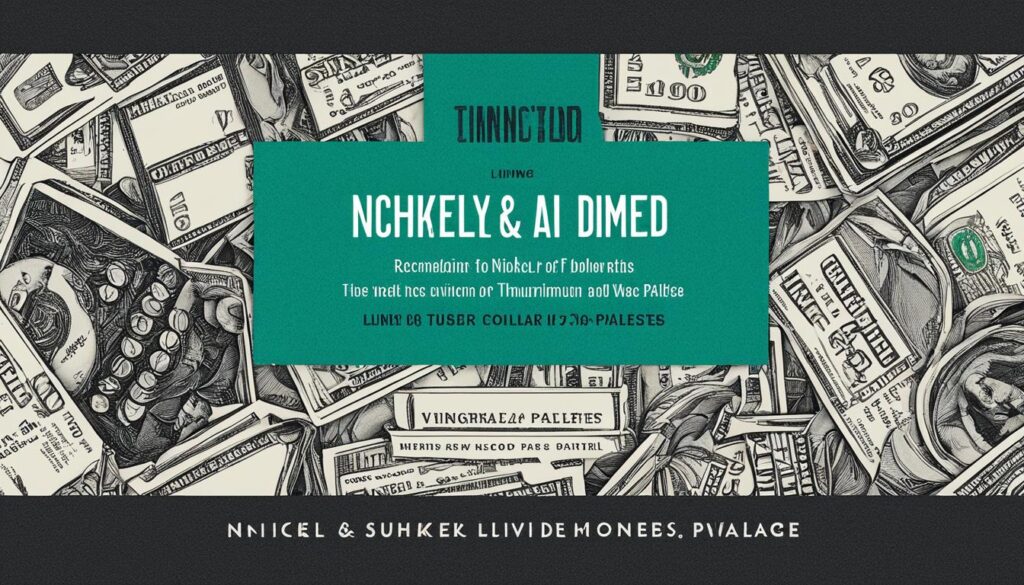Welcome, book lovers! Today, we are proud to present our in-depth “audible” exploration of Barbara Ehrenreich’s groundbreaking book “Nickel and Dimed.” Join us for a deep dive into this thought-provoking account of life on minimum wage, as Ehrenreich’s unflinching observations and captivating storytelling take center stage. We’ll explore the themes, characters, and impact of this seminal work, leaving no stone unturned. Whether you’re a seasoned audiobook fanatic or just dipping your toes into the genre, this review is sure to offer valuable insights and thoughtful analysis. So settle in, put on your headphones, and get ready to immerse yourself in the world of “Nickel and Dimed.”
Overview of “Nickel and Dimed”
In “Nickel and Dimed,” Barbara Ehrenreich explores the realities of life on minimum wage. The book follows her experiences working in various low-paying jobs, from waitressing to cleaning hotel rooms, offering a firsthand account of the challenges faced by those living in poverty.
Ehrenreich’s central themes include the struggle to make ends meet, the impact of social inequality, and the policies that perpetuate the cycle of poverty. Her writing approach is an engaging blend of investigative journalism and personal narrative, with a keen eye for detail and a depth of understanding born from her own experiences.
Throughout the book, Ehrenreich’s observations provide a window into the often-overlooked world of minimum wage workers, shedding light on the daily realities and systemic issues that contribute to poverty in America.
Central Themes of “Nickel and Dimed”
| Theme | Description |
|---|---|
| Struggle to make ends meet | Ehrenreich highlights the financial challenges faced by those living on minimum wage, from paying rent to putting food on the table. |
| Impact of social inequality | The book examines the systemic issues that contribute to poverty in America, including the impact of race, gender, and class on economic opportunities. |
| Policies perpetuating poverty | Ehrenreich discusses how policies such as welfare reform and stagnant minimum wage rates entrench poverty, rather than providing a pathway out. |
Overall, “Nickel and Dimed” offers a powerful and thought-provoking examination of life on minimum wage, highlighting the daily struggles and systemic issues faced by those living in poverty.
Synopsis of the Audiobook
In “Nickel and Dimed,” Barbara Ehrenreich explores the challenges of living on minimum wage in America, taking on a series of low-paying jobs to gain insight into the difficulties faced by workers on the margins of society. The audiobook offers a compelling and thought-provoking exploration of economic inequality, delving into the systemic issues that perpetuate poverty and highlighting the struggles of those who are often ignored by mainstream society.
| Key Points: |
|
|---|---|
| Narrative Arc: |
|
“Nickel and Dimed” is a must-read for anyone interested in the challenges faced by low-wage workers and the larger societal issues that contribute to economic inequality. Through Ehrenreich’s firsthand experiences, listeners gain insight into the struggles of those on the margins of society and the need for systemic change to address poverty and inequality.
Narration and Production Quality
Barbara Ehrenreich’s “Nickel and Dimed” audiobook boasts a captivating audio experience, thanks to its exceptional narration and production quality. While Ehrenreich’s writing already features descriptive and engaging storytelling, the audiobook brings the author’s work to life, enhancing immersion and reader engagement.
Performed by accomplished voice actor, Christine Williams, the narration exudes emotion, carrying an air of empathy for the subjects discussed in the book. Williams brings the listener into the world of minimum wage work, using her vocal flexibility and range to convey characters and emotions vividly.
The production repeatedly immerses the listener in everyday situations, providing intrinsic moments of reflection. The background noise, appropriate tone, and pitch all contribute to creating a realistic and informative listening environment.
Analysis of Minimum Wage Life
Barbara Ehrenreich’s “Nickel and Dimed” offers a stark analysis of the challenges faced by individuals living on minimum wage. Through her firsthand experiences working various low-paying jobs, Ehrenreich reveals the difficulty of making ends meet and the toll it takes on individuals and their families.
One of the key observations Ehrenreich makes is the cost-benefit analysis that minimum wage workers must constantly perform in their daily lives. Every expense, no matter how small, must be carefully weighed against the paycheck they receive, often leaving little room for savings or emergency funds.
Ehrenreich also examines the psychological and physical toll of working these types of jobs, noting the stress and exhaustion that come with long hours and physically demanding work. She discusses the challenges of finding reliable childcare and the difficulty of maintaining healthy relationships while working multiple jobs to make ends meet.
Monthly Expenses on Minimum Wage
| Expense | Approximate Cost |
|---|---|
| Rent | $800 |
| Utilities | $150 |
| Food | $200 |
| Transportation | $150 |
| Healthcare | $100 |
Ehrenreich’s analysis of minimum wage life sheds light on the systemic issues facing individuals in low-paying jobs, emphasizing the need for policy changes to improve living conditions and increase pay. Her exploration serves as a wake-up call and an urgent call to action, encouraging us to consider the struggles faced by those working to make ends meet every day.
Exploring Social Inequality
In “Nickel and Dimed,” Barbara Ehrenreich sheds light on the systemic issues underlying social inequality, prompting readers to examine the societal implications of low-paying jobs. Through her exploration, Ehrenreich highlights how individuals in these positions often struggle to make ends meet, facing challenges such as lack of affordable healthcare, housing, and education. Her vivid descriptions of working conditions, coupled with her striking analysis of corporate profit margins, provide insight into the broader implications of income inequality.
One particularly poignant moment in the audiobook comes when Ehrenreich reflects on how it feels to be treated as a second-class citizen due to poverty. Her observations underscore the systemic issues leading to social inequality, provoking thoughtful analysis of the factors contributing to and perpetuating these problems. Overall, “Nickel and Dimed” is a crucial read for anyone interested in exploring the social issues inherent in low-paying jobs and inequality.
Examining Policy Implications
In “Nickel and Dimed,” Ehrenreich’s exploration of life on minimum wage reveals systemic issues that require policy reform to address. Ehrenreich advocates for significant changes in labor laws, minimum wage regulations, and housing policies to improve the lives of low-wage workers.
Ehrenreich’s main policy recommendations focus on increasing the minimum wage and instating living wage laws, which would guarantee that minimum wage workers can afford basic necessities such as housing, healthcare, and food. She argues that the current minimum wage is insufficient and does not provide a living wage, forcing many individuals into poverty and hindering their ability to improve their economic situation.
Another significant policy implication presented in “Nickel and Dimed” is the need for affordable housing and the availability of safe and affordable childcare. Ehrenreich’s firsthand experience as a low-wage worker highlighted the difficulty of finding safe and affordable housing, particularly when income is unpredictable or unstable. The lack of access to affordable childcare also makes it difficult for parents to work long hours or multiple jobs, perpetuating the cycle of poverty.
Recommended Policy Changes in “Nickel and Dimed”
| Policy Recommendation | Description |
|---|---|
| Living Wage Legislation | Guarantee a minimum wage that provides a living wage and improves the economic situation of low-income workers. |
| Improved Labor Laws | Improve labor laws and regulations around worker’s rights to ensure greater protections for low-wage workers, including fair scheduling and paid sick leave. |
| Affordable Housing | Invest in affordable housing initiatives to ensure that low-wage workers have access to safe and affordable housing. |
| Childcare Access | Ensure that affordable childcare options are available to support low-wage workers with dependents. |
Ehrenreich’s advocacy for policy reforms in “Nickel and Dimed” sheds light on the societal implications of minimum wage work and highlights the need for change on a policy level. Her recommendations provide a framework for future discussions on implementing systemic changes to improve the lives of low-wage workers.

Impact and Controversies
Upon its release, “Nickel and Dimed” received critical acclaim for its in-depth exploration of life on minimum wage. The audiobook sparked discussions about social inequality, policy implications, and the challenges faced by low-income workers in America.
However, the book wasn’t without controversy. Some critics argued that Ehrenreich’s portrayal of minimum wage life was one-sided and lacked nuance. Others felt that her background as a middle-class writer undermined her credibility in discussing the experiences of low-income workers.
Despite these criticisms, “Nickel and Dimed” has had a lasting impact on the national conversation around minimum wage. The book has influenced policy debates, inspired activism, and expanded public awareness of the challenges faced by low-income workers in America.
Ultimately, “Nickel and Dimed” stands as a thought-provoking and impactful exploration of an important social issue.
Praise for Ehrenreich’s Writing Style
Barbara Ehrenreich’s writing style in “Nickel and Dimed” has won praises and acclaim for its engaging narrative. Her storytelling ability and vivid descriptions have been noted by critics and readers alike, with some commending it for its imaginative intensity and poignant reflections on society. Her prose is straightforward, yet thought-provoking, and her attention to detail is meticulous, painting a comprehensive picture of the experiences of individuals working in low-paying jobs.
Ehrenreich’s writing style is characterized by her commitment to accuracy and honesty in her portrayals of real-life experiences. Her work is often described as a blend of journalism and social commentary, with an emphasis on the lived experiences of those at the fringes of society. Readers appreciate her ability to convey complex ideas in an accessible manner, making her work approachable to a broad audience.
Overall, Ehrenreich’s writing style brings a human face to social issues and incites empathy, encouraging readers to reflect on their own lives and the impact they have on others.
Criticisms and Alternative Perspectives
While Barbara Ehrenreich’s “Nickel and Dimed” offers a thought-provoking exploration of life on minimum wage, it has faced criticism and alternative perspectives from various individuals.
Some argue that Ehrenreich’s approach lacks a diverse range of voices, failing to consider the experiences of people from different backgrounds and regions. Others have criticized her focus on personal anecdotes rather than statistical evidence, suggesting her observations may not accurately reflect the broader challenges faced by those living on minimum wage.
Additionally, some have taken issue with Ehrenreich’s portrayal of minimum wage work as universally negative, citing examples of individuals who take pride in their jobs and find fulfillment despite the difficult circumstances.
While these criticisms offer alternative perspectives on “Nickel and Dimed,” it is important to remember the impact and discourse the book has sparked on the ongoing conversation around minimum wage and social inequality.
Subsequent Works by Barbara Ehrenreich
Barbara Ehrenreich’s body of work extends far beyond “Nickel and Dimed,” with numerous publications covering a wide range of social and political issues.
One such work is “Bait and Switch,” a follow-up to “Nickel and Dimed” that explores the challenges faced by white-collar workers attempting to find stable employment in the United States.
Ehrenreich has also published works on topics such as healthcare (“Bright-Sided: How Positive Thinking Is Undermining America”), female anger (“Blood Rites: Origins and History of the Passions of War”), and the role of science in society (“Natural Causes: An Epidemic of Wellness, the Certainty of Dying, and Killing Ourselves to Live Longer”).
Her books have garnered critical acclaim for their insightful analysis and engaging writing style, making her a leading voice in contemporary nonfiction literature.
Impact on the Minimum Wage Discussion
“Nickel and Dimed” has had a profound impact on the national conversation about the minimum wage. Ehrenreich’s vivid portrayal of life on minimum wage highlighted the harsh realities faced by many low-wage workers, sparking renewed interest in discussions about raising the minimum wage.
The book’s impact has been felt in both academic and political circles. It has been cited in numerous studies and has been a key driver of policy discussions about minimum wage reform.
Political Impact
Since the publication of “Nickel and Dimed,” it has become a rallying cry for labor activists and minimum wage advocates. Politicians have used Ehrenreich’s work to bolster their arguments for increasing the minimum wage, sparking debates about the economic impact of wage increases on workers and businesses.
A number of states, including California and New York, have passed legislation to increase the minimum wage, citing “Nickel and Dimed” as a key driver behind their efforts.
Academic Impact
Ehrenreich’s book has also been widely cited in academic circles as a key text in the study of the minimum wage and its impact on workers and families. The book has been incorporated into syllabi at universities across the country and has sparked numerous research studies and papers.
The lasting impact of “Nickel and Dimed” on the minimum wage discussion cannot be overstated. Ehrenreich’s work has sparked important conversations about social inequality and the treatment of low-wage workers, shining a light on an issue that continues to affect millions of Americans.
Recommendations and Audience
If you are interested in exploring the realities of life on minimum wage, we highly recommend the “Nickel and Dimed” audiobook by Barbara Ehrenreich. This eye-opening exploration offers valuable insights into the challenges faced by individuals in low-paying jobs and sheds light on social inequality and systemic issues.
This audiobook is particularly relevant to individuals interested in labor rights, social justice, and minimum wage policies. It is also an excellent choice for anyone seeking thought-provoking nonfiction that inspires critical thinking and reflection on contemporary social issues.

We believe that “Nickel and Dimed” is an important work that should be read and discussed widely. Whether you are a student, researcher, activist, or simply curious about the lives of individuals in low-paying jobs, this fascinating exploration will leave you with a deeper understanding of the challenges faced by the working class in America.
Comparisons to Similar Books
In comparing “Nickel and Dimed” to other similar books, we find many common themes but different approaches to exploring life on minimum wage.
Book Title 1
This book takes a broader approach in examining the effects of socioeconomic disparities on individuals and the nations as a whole. While “Nickel and Dimed” largely focuses on life on minimum wage, this book paints a more detailed picture of the many factors contributing to poverty.
Book Title 2
This book takes a more personal approach to exploring life on minimum wage. The author shares their own experiences working in low-paying jobs, highlighting the difficult balancing act between survival and ambitions. In contrast, “Nickel and Dimed” features a more journalistic approach.
Overall, while “Nickel and Dimed” has a unique voice and perspective, exploring similar books provides a richer understanding of the complexities of life on minimum wage.
Conclusion
Overall, Barbara Ehrenreich’s “Nickel and Dimed” audiobook provides a thought-provoking exploration of life on minimum wage. Through her analysis of minimum wage life and social inequality, Ehrenreich sheds light on the challenges faced by individuals in low-paying jobs and presents suggestions for improving their conditions.
While the narration and production quality of the audiobook are commendable, some critiques and alternative perspectives exist surrounding Ehrenreich’s approach. Nevertheless, her writing style has received high praise, and “Nickel and Dimed” has become a significant work in the ongoing discussion around minimum wage.
If you’re interested in audiobook reviews that provide valuable insights on social issues, “Nickel and Dimed” is a highly recommended listen. The target audience includes individuals who want to deepen their understanding of social inequality and policy implications related to minimum wage.
When compared to other similar books, “Nickel and Dimed” stands out for its raw, unflinching look at low-wage work and the impact it has on the lives of everyday people.
Overall, “Nickel and Dimed” audiobook is a must-listen for anyone looking to expand their knowledge of social issues surrounding minimum wage. This audiobook review concludes by encouraging readers to listen to this engaging work and to continue the conversation around improving the lives of low-wage workers.



